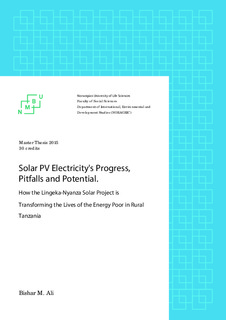| dc.contributor.author | Ali, Bishar M. | |
| dc.date.accessioned | 2016-04-04T12:49:55Z | |
| dc.date.available | 2016-04-04T12:49:55Z | |
| dc.date.issued | 2016-04-04 | |
| dc.identifier.uri | http://hdl.handle.net/11250/2383793 | |
| dc.description.abstract | Energy poverty in the rural areas of Sub-Saharan Africa is one of the main barriers that hinder development. In Tanzania there have been numerous efforts to enable the rural poor access clean and modern sources of energy but these have had limited results. The major reason is that current top-down approaches fail to benefit the energy poor. Decentralized off-grid renewable energy technologies promoted through a bottom-up approach which empowers the poor giving them the responsibility to choose, apply and adapt technology to their communities is increasingly seen as
a viable alternative.
In 2011 a solar project under the Climate Change Impacts, Adaptation and Mitigation program was introduced in two remote, un-electrified rural villages in northern Tanzania; Lingeka and Nyanza. This project introduced solar home systems and solar lanterns in these villages and using a barefoot approach trained four women to become barefoot solar engineers, established a village energy committee and a rural energy workshop. In addition the project used an innovative social entrepreneurship business model that allowed the residents to payback for the solar equipment in installments. This money was then used to buy more solar equipment to be sold.
Using both quantitative and qualitative methods, this study examines the socioeconomic impact of the project, how the project impacts empowerment of the women solar engineers and examines the success factors and challenges of the model used to promote solar PV. The study finds that access to affordable solar PV electricity has also enabled households to light up their small business and earn extra income by charging mobile phones for a fee. Pupils in this homes study 1-4 hours more after dark have improved grades. Residents of these villages have also better security at night and are less prone to health hazards associated with kerosene lamps. The study also finds that the solar project has contributed to transformation of gender roles and empowered
the four female barefoot solar engineers. These women have not only transformed their villages by providing crucial after sale services but also improved their agency, well being and status in the community.
In solving energy poverty, modern technology is only one piece of the puzzle. Innovative models bridge the gap between solar PV technology and the rural energy poor, as demonstrated by the Lingeka-Nyanza model. This model overcomes major technical, social and institutional Barriers that have hindered absorption of solar technology in rural areas by establishing an innovative locally adapted model. Through its innovative social entrepreneurship model, it offers a practical sustainable solution that promises great potential for providing other rural villages with access to solar PV electricity. This study recommends this model to be scaled up as one solution to energy poverty in rural Tanzania. | nb_NO |
| dc.language.iso | eng | nb_NO |
| dc.publisher | Norwegian University of Life Sciences, Ås | |
| dc.rights | Navngivelse 3.0 Norge | * |
| dc.rights.uri | http://creativecommons.org/licenses/by/3.0/no/ | * |
| dc.subject | Energy poverty | nb_NO |
| dc.subject | Solar PV Technology | nb_NO |
| dc.subject | Rural | nb_NO |
| dc.subject | Tanzania | nb_NO |
| dc.title | Solar PV electricity's progress, pitfalls and potential : how the Lingeka-Nyanza solar project is transforming the lives of the energy poor in rural Tanzania | nb_NO |
| dc.type | Master thesis | nb_NO |
| dc.subject.nsi | VDP::Social science: 200::Women's and gender studies: 370 | nb_NO |
| dc.subject.nsi | VDP::Social science: 200::Human geography: 290 | nb_NO |
| dc.subject.nsi | VDP::Social science: 200::Sociology: 220 | nb_NO |
| dc.source.pagenumber | 116 | nb_NO |
| dc.description.localcode | M-DS | nb_NO |

